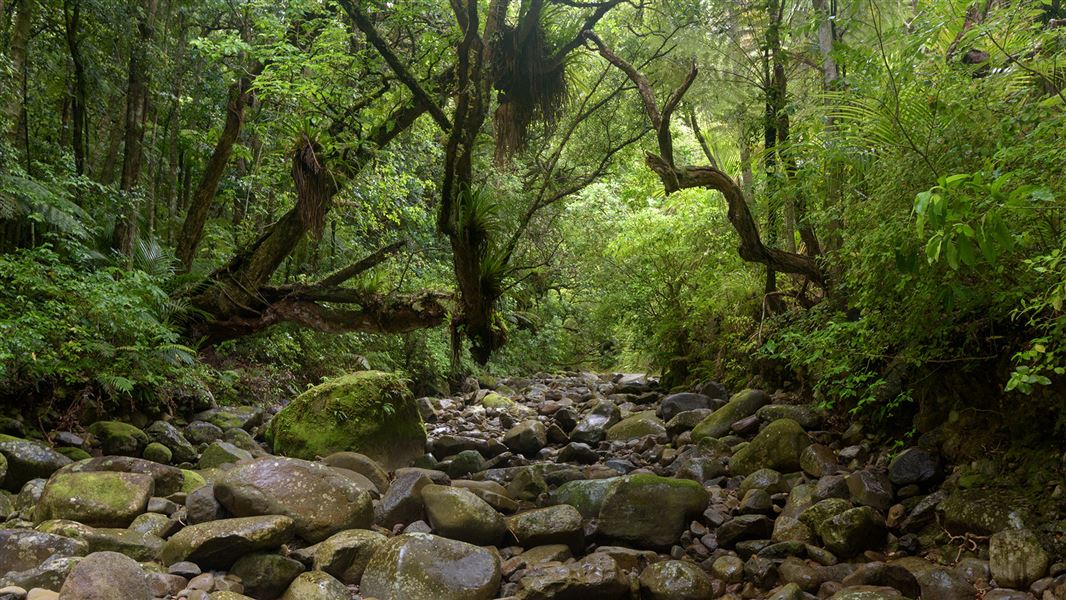Te Hauturu-o-Toi/Little Barrier Island was New Zealand's first nature reserve. It is the only large forested area left in the country relatively undisturbed by browsing mammals, and is an invaluable refuge for rare and endangered plants, birds and animals whose mainland habitats have been destroyed.
Situated 22 km from Cape Rodney and 18 km from Great Barrier Island (Aotea), Little Barrier Island is roughly circular in shape. Its highest point is Mt Hauturu at 722 above sea level. Comprising of 3083 hectares, the island is volcanic in origin, mountainous and heavily forested except for the 27 hectares of flat land, known as Te Maraeroa, on the island's south-west corner. Te Maraeroa is also the location of the island's bunkhouse and ranger's accommodation.
Te Hauturu-o-Toi, the island's Maori name, can be interpreted as the 'wind's resting post' and the cloud cap that more often than not envelopes the top of the island creates exactly this impression when viewed from a distance.
The island's flora
Little Barrier, the only large forested area in New Zealand relatively undisturbed by introduced browsing mammals, provides a unique glimpse of primeval New Zealand. Distinct vegetation zones are present, from the pohuehue (Muehlenbeckia complexa) covered boulders and pohutukawa forest on the coastal fringe through coastal kohekohe, puriri and taraire forest to thirty metre tall kauri forest.
Northern rata and tawaroa predominate at mid-altitudes, especially in the valleys, with hard beech a feature on many ridges. At higher altitudes, cloud forest dominated by tawheowheo (Quintinia serrata), tawari (Ixerba brexioides) and southern rata can be found. Filmy ferns, mosses and liverworts abound in this moist environment created by the near constant envelope of cloud.
While there are no higher plant species known only from Little Barrier, the island is home to over 400 native species, including a number now seldom seen on the mainland. These include: parapara (Pisonia brunoniana), with its sticky seeds that can ensnare small birds; mawhai, the native cucumber (Sicyos australis) scrambling under coastal shade; waiu-atua, the endangered shore spurge (Euphorbia glauca) at home amongst the boulders just above high tide; and the endangered giant flowered broom (Carmichaelia williamsii), locally common at the foot of coastal cliffs around the north-east.
Unfortunately, Little Barrier did not entirely escape human disturbance. Nearly one third of the island's forest cover was cut and burnt prior to Crown purchase, and cattle once roamed widely. Most areas that were cleared have now regenerated back to kanuka (Kunzea ericoides) forest and are now in a state of transition back to the original forest cover dominated by kauri and broadleaf species.
A more insidious threat to the long term integrity of the island's vegetation arises from weed species that have reached and are continuing to reach the island. About 150 exotic species were present, mostly concentrated around sites of human occupation at Te Maraeroa.
Although this total has now been substantially reduced, a few weed species have become widespread, including pampas, climbing asparagus and Mexican Devil. Continued vigilance is required to avoid further unwanted weeds establishing.
The island's fauna
A campaign to eradicate feral cats on the island was successfully concluded in June 1980 and an operation to remove kiore was completed in July 2004. The success of the kiore eradication has been confirmed following intensive monitoring in 2006.
Beneficial effects from the removal of cats such as an increase in the number of black petrels breeding on the island have been notable and it is expected that many more changes will be observed over the years subsequent to kiore removal. Over time it is expected that natural processes will restore a diverse self-sustaining forest system with large numbers of burrowing seabirds, lizards and insects.
The removal of cats and kiore will contribute enormously to the recovery of threatened species such as the wetapunga (giant weta), New Zealands largest insect, and hihi (stitchbird) for whom Little Barrier Island has been the last refuge for over 100 years.
Kokako and tieke (saddleback) were liberated following cat eradication and have flourished. Seabirds previously exterminated by cats and kiore are returning and tuatara held in captivity on the island have finally been released, with the hope they will go on to create a large self sustaining population.
Chevron and striped skink populations will also recover while other species unable to coexist with kiore such as the smaller burrowing seabirds, the large Cyclodina skinks and snipe may one day be reestablished.
Many other native birds thrive on the island including kiwi, tui, korimako (bellbird), both red and yellow crowned kakariki (parakeets), pateke (brown teal), kereru (wood pigeon), miromiro (tomtit), titipounamu (rifleman), riroriro (grey warbler), korora (blue penguin), popokatea (whitehead) and karuhiruhi (pied shag).
With over 40 species of birds permanently or seasonally present, two bat species and 14 species of reptiles, the island supports the most diverse assemblage of native fauna of any island in the country. Because of this, and the fact the island is free of most introduced predators, it is considered to be one of the most important reserves of its kind in the world.
